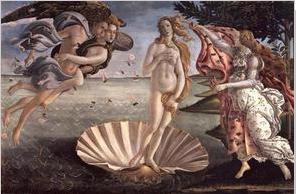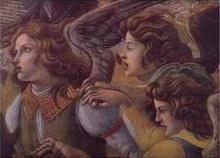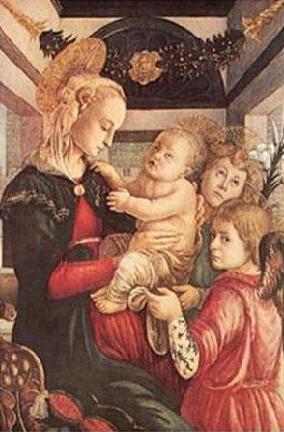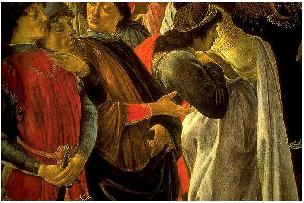
Candida Martinelli's Italophile Site

Main
Page This family-friendly site celebrates Italian culture for the enjoyment of children and
adults. Site-Overview
Knights of Art -
Sandro Botticelli
Visit
my Angels in Italian Art Page
Visit
my Canaletto and Venice Art Page On-line
images of art at Web Gallery
of Art: We
must now go back to the days when Fra Filippo Lippi painted his pictures
and so brought fame to the Carmine Convent. There
was at that time in Florence a good citizen called Mariano Filipepi, an
honest, well-to-do man, who had several sons. These sons were all taught
carefully and well trained to do each the work he chose. But the fourth
son, Alessandro, or Sandro as he was called, was a great trial to his
father. He would settle to no trade or calling. Restless and uncertain,
he turned from one thing to another. At one time he would work with all
his might, and then again become as idle and fitful as the summer
breeze. He could learn well and quickly when he chose, but then there
were so few things that he did choose to learn. Music he loved, and he
knew every song of the birds, and anything connected with flowers was a
special joy to him. No one knew better than he how the different kinds
of roses grew, and how the lilies hung upon their stalks. The Virgin and Eight Angles
(detail) by Botticelli `And
what, I should like to know, is going to be the use of all this,' the
good father would say impatiently, `as long as thou takest no pains to
read and write and do thy sums? What am I to do with such a boy, I
wonder?' Then
in despair the poor man decided to send Sandro to a neighbour's
workshop, to see if perhaps his hands would work better than his head. The
name of this neighbour was Botticelli, and he was a goldsmith, and a
very excellent master of his art. He agreed to receive Sandro as his
pupil, so it happened that the boy was called by his master's name, and
was known ever after as Sandro Botticelli. Sandro
worked for some time with his master, and quickly learned to draw
designs for the goldsmith's work. In
those days painters and goldsmiths worked a great deal together, and
Sandro often saw designs for pictures and listened to the talk of the
artists who came to his master's shop. Gradually, as he looked and
listened, his mind was made up. He would become a painter. All his
restless longings and day dreams turned to this. All the music that
floated in the air as he listened to the birds' song, the gentle dancing
motion of the wind among the trees, all the colours of the flowers, and
the graceful twinings of the rose-stems--all these he would catch and
weave into his pictures. Yes, he would learn to painst music and motion,
and then he would be happy. Birth of Venus (detail) by
Botticelli `So
now thou wilt become a painter,' said his father, with a hopeless sigh. Truly
this boy was more trouble than all the rest put together. Here he had
just settled down to learn how to become a good goldsmith, and now he
wished to try his hand at something else. Well, it was no use saying
`no.' The boy could never be made to do anything but what he wished.
There was the Carmelite monk Fra Filippo Lippi, of whom all, men were
talking. It was said he was the greatest painter in Florence. The boy
should have the best teaching it was possible to give him, and perhaps
this time he would stick to his work. So
Sandro was sent as a pupil to Fra Filippo, and he soon became a great
favourite with the happy, sunny-tempered master. The quick eye of the
painter soon saw that this was no ordinary pupil. There was something
about Sandro's drawing that was different to anything that Filippo had
ever seen before. His figures seemed to move, and one almost heard the
wind rustling in their flowing drapery. Instead of walking, they seemed
to be dancing lightly along with a swaying motion as if to the rhythm of
music. The very rose-leaves the boy loved to paint, seemed to flutter
down to the sound of a fairy song. Filippo was proud of his pupil. Birth of Venus by Botticelli `The
world will one day hear more of my Sandro Botticelli,' he said; and,
young though the boy was, he often took him to different places to help
him in his work. So
it happened that in that wonderful spring of Filippo's life, Sandro too
was at Prato, and worked there with Fra Diamante. And in later years
when the master's little daughter was born, she was named Alessandra,
after the favourite pupil, to whom was also left the training of little
Filippino. Now,
indeed, Sandro's good old father had no further cause to complain. The
boy had found the work he was most fitted for, and his name soon became
famous in Florence. It
was the reign of gaiety and pleasure in the city of Florence at that
time. Lorenzo the Magnificent, the son of Cosimo de Medici, was ruler
now, and his court was the centre of all that was most splendid and
beautiful. Rich dresses, dainty food, music, gay revels, everything that
could give pleasure, whether good or bad, was there. Lorenzo,
like his father, was always glad to discover a new painter, and
Botticelli soon became a great favourite at court. But
pictures of saints and angels were somewhat out of fashion at that time,
for people did not care to be reminded of anything but earthly
pleasures. So Botticelli chose his subjects to please the court, and for
a while ceased to paint his sad-eyed Madonnas. Nastasio degli Onesto by
Botticelli What
mattered to him what his subject was? Let him but paint his dancing
figures, tripping along in their light flowing garments, keeping time to
the music of his thoughts, and the subject might be one of the old Greek
tales or any other story that served his purpose. All
the gay court dresses, the rich quaint robes of the fair ladies, helped
to train the young painter's fancy for flowing draperies and wonderful
veils of filmy transparent gauze. There
was one fair lady especially whom Sandro loved to paint--the beautiful
Simonetta, as she is still called. First
he painted her as Venus, who was born of the sea foam. In his picture
she floats to the shore standing in a shell, her golden hair wrapped
round her. The winds behind blow her onward and scatter pink and red
roses through the air. On the shore stands Spring, who holds out a
mantle, flowers nestling in its folds, ready to enwrap the goddess when
the winds shall have wafted her to land. Then
again we see her in his wonderful picture of `Spring,' and in another
called `Mars and Venus.' She was too great a lady to stoop to the humble
painter, and he perhaps only looked up to her as a star shining in
heaven, far out of the reach of his love. But he never ceased to worship
her from afar. He never married or cared for any other fair face, just
as the great poet Dante, whom Botticelli admired so much, dreamed only
of his one love, Beatrice. La Primavera by Botticelli But
Sandro did not go sadly through life sighing for what could never be
his. He was kindly and good-natured, full of jokes, and ready to make
merry with his pupils in the workshop. It
once happened that one of these pupils, Biagio by name, had made a copy
of one of Sandro's pictures, a beautiful Madonna surrounded by eight
angels. This he was very anxious to sell, and the master kindly promised
to help him, and in the end arranged the matter with a citizen of
Florence, who offered to buy it for six gold pieces. `Well,
Biagio,' said Sandro, when his pupil came into the studio next morning,
`I have sold thy picture. Let us now hang it up in a good light that the
man who wishes to buy it may see it at its best. Then will he pay thee
the money.' Biagio
was overjoyed. `Oh,
master,' he cried, `how well thou hast done.' Then
with hands which trembled with excitement the pupil arranged the picture
in the best light, and went to fetch the purchaser. Now
meanwhile Botticelli and his other pupils had made eight caps of scarlet
pasteboard such as the citizens of Florence then wore, and these they
fastened with wax on to the heads of the eight angels in the picture. Presently
Biagio came back panting with joyful excitement, and brought with him
the citizen, who knew already of the joke. The poor boy looked at his
picture and then rubbed his eyes. What had happened? Where were his
angels? The picture must be bewitched, for instead of his angels he saw
only eight citizens in scarlet caps. Coronation (detail) by
Botticelli He
looked wildly around, and then at the face of the man who had promised
to buy the picture. Of course he would refuse to take such a thing. But,
to his surprise, the citizen looked well pleased, and even praised the
work. `It
is well worth the money,' he said; `and if thou wilt return with me to
my house, I will pay thee the six gold pieces.' Biagio
scarcely knew what to do. He was so puzzled and bewildered he felt as if
this must be a bad dream. As
soon as he could, he rushed back to the studio to look again at that
picture, and then he found that the red-capped citizens had disappeared,
and his eight angels were there instead. This of course was not
surprising, as Sandro and his pupils had quickly removed the wax and
taken off the scarlet caps. `Master,
master,' cried the astonished pupil, `tell me if I am dreaming, or if I
have lost my wits? When I came in just now, these angels were Florentine
citizens with red caps on their heads, and now they are angels once
more. What may this mean?' `I
think, Biagio, that this money must have turned thy brain round,' said
Botticelli gravely. `If the angels had looked as thou sayest, dost thou
think the citizen would have bought the picture?' `That
is true,' said Biagio, shaking his head solemnly; `and yet I swear I
never saw anything more clearly.' And
the poor boy, for many a long day, was afraid to trust his own eyes,
since they had so basely deceived him. But
the next thing that happened at the studio did not seem like a joke to
the master, for a weaver of cloth came to live close by, and his looms
made such a noise and such a shaking that Sandro was deafened, and the
house shook so greatly that it was impossible to paint. Madonna and Child with Angels
by Botticelli But
though Botticelli went to the weaver and explained all this most
courteously, the man answered roughly, `Can I not do what I like with my
own house?' So Sandro was angry, and went away and immediately ordered a
great square of stone to be brought, so big that it filled a wagon. This
he had placed on the top of his wall nearest to the weaver's house, in
such a way that the least shake
would bring it crashing down into the enemy's workshop. When
the weaver saw this he was terrified, and came round at once to the
studio. `Take
down that great stone at once,' he shouted. `Do you not see that it
would crush me and my workshop if it fell?' `Not
at all,' said Botticelli. `Why should I take it down? Can I not do as I
like with my own house?' And
this taught the weaver a lesson, so that he made less noise and shaking,
and Sandro had the best of the joke after all. There
were no idle days of dreaming now for Sandro. As soon as one picture was
finished another was wanted. Money flowed in, and his purse was always
full of gold, though he emptied it almost as fast as it was filled. His
work for the Pope at Rome alone was so well paid that the money should
have lasted him for many a long day, but in his usual careless way he
spent it all before he returned to Florence. Perhaps
it was the gay life at Lorenzo's splendid court that had taught him to
spend money so carelessly, and to have no thought but to eat, drink, and
be merry. But very soon a change began to steal over his life. The Three Graces by Botticelli There
was one man in Florence who looked with sad condemning eyes on all the
pleasure-loving crowd that thronged the court of Lorenzo the
Magnificent. In the peaceful convent of San Marco, whose walls the
angel-painter had covered with pictures `like windows into heaven,' the
stern monk Savonarola was grieving over the sin and vanity that went on
around him. He loved Florence with all his heart, and he could not bear
the thought that she was forgetting, in the whirl of pleasure, all that
was good and pure and worth the winning. Then,
like a battle-cry, his voice sounded through the city, and roused the
people from their foolish dreams of ease and pleasure. Every one flocked
to the great cathedral to hear Savonarola preach, and Sandro Botticelli
left for a while his studio and his painting and became a follower of
the great preacher. Never again did he paint those pictures of earthly
subjects which had so delighted Lorenzo. When he once more returned to
his work, it was to paint his sad-eyed Madonnas; and the music which
still floated through his visions was now like the song of angels. The
boys of Florence especially had grown wild and rough during the reign of
pleasure, and they were the terror of the city during carnival time.
They would carry long poles, or `stili,' and bar the streets across,
demanding money before they would let the people pass. This money they
spent on drinking and feasting, and at night they set up great trees in
the squares or wider streets and lighted huge bonfires around them. Then
would begin a terrible fight with stones, and many of the boys were
hurt, and some even killed. No
one had been able to put a stop to this until Savonarola made up his
mind that it should cease. Then, as if by magic, all was changed. Instead
of the rough game of `stili,' there were altars put up at the corners of
the streets, and the boys begged money of the passers-by, not for their
feasts, but for the poor. The Annunciation by Botticelli `You
shall not miss your bonfire,' said Savonarola; `but instead of a tree
you shall burn up vain and useless things, and so purify the city.' So
the children went round and collected all the `vanities,' as they were
called--wigs and masks and carnival dresses, foolish songs, bad books,
and evil pictures; all were heaped high and then lighted to make one
great bonfire. Some
people think that perhaps Sandro threw into the Bonfire of Vanities some
of his own beautiful pictures, but that we cannot tell. Then
came the sad time when the people, who at one time would have made
Savonarola their king, turned against him, in the same fickle way that
crowds will ever turn. And then the great preacher, who had spent his
life trying to help and teach them, and to do them good, was burned in
the great square of that city which he had loved so dearly. After
this it was long before Botticelli cared to paint again. He was old and
weary now, poor and sad, sick of that world which had treated with such
cruelty the master whom he loved. One
last picture he painted to show the triumph of good over evil. Not with
the sword or the might of great power is the triumph won, says Sandro to
us by this picture, but by the little hand of the Christ Child,
conquering by love and drawing all men to Him. This Adoration of the
Magi is in our own National Gallery in London, and is the only painting
which Botticelli ever signed. `I,
Alessandro, painted this picture during the troubles of Italy ... when
the devil was let loose for the space of three and a half years.
Afterwards shall he be chained, and we shall see him trodden down as in
this picture.' Adoration of the Magi (detail
of de Medici) by Botticelli It
is evident that Botticelli meant by this those sad years of struggle
against evil which ended in the martyrdom of the great preacher, and he
has placed Savonarola among the crowd of worshippers drawn to His feet
by the Infant Christ. It
is sad to think of those last days when Sandro was too old and too weary
to paint. He who had loved to make his figures move with dancing feet,
was now obliged to walk with crutches. The roses and lilies of spring
were faded now, and instead of the music of his youth he heard only the
sound of harsh, ungrateful voices, in the flowerless days of poverty and
old age. There
is always something sad too about his pictures, but through the sadness,
if we listen, we may hear the angel-song, and understand it better if we
have in our minds the prayer which Botticelli left for us.
`Oh, King of Wings and Lord of Lords, who alone
rulest always in eternity, and who correctest all our wanderings, giver
of melody to the choir of angels, listen Thou a little to our bitter
grief, and come and rule us, oh Thou highest King, with Thy love which
is so sweet.'
Return to:
Stories of the Italian Painters
by Amy Steedman









